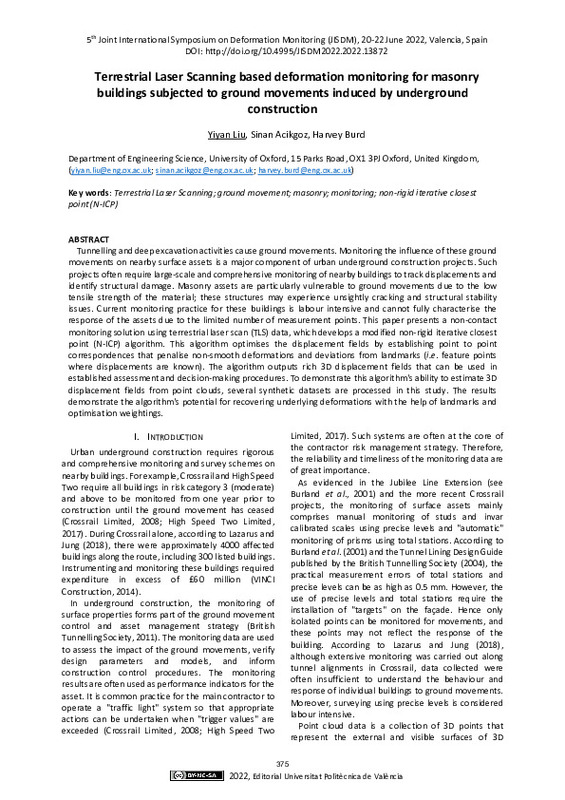JavaScript is disabled for your browser. Some features of this site may not work without it.
Buscar en RiuNet
Listar
Mi cuenta
Estadísticas
Ayuda RiuNet
Admin. UPV
Terrestrial Laser Scanning based deformation monitoring for masonry buildings subjected to ground movements induced by underground construction
Mostrar el registro sencillo del ítem
Ficheros en el ítem
| dc.contributor.author | Liu, Yiyan
|
es_ES |
| dc.contributor.author | Acikgoz, Sinan
|
es_ES |
| dc.contributor.author | Burd, Harvey
|
es_ES |
| dc.date.accessioned | 2023-02-14T13:51:10Z | |
| dc.date.available | 2023-02-14T13:51:10Z | |
| dc.date.issued | 2023-01-27 | |
| dc.identifier.isbn | 9788490489796 | |
| dc.identifier.uri | http://hdl.handle.net/10251/191830 | |
| dc.description.abstract | [EN] Tunnelling and deep excavation activities cause ground movements. Monitoring the influence of these ground movements on nearby surface assets is a major component of urban underground construction projects. Such projects often require large-scale and comprehensive monitoring of nearby buildings to track displacements and identify structural damage. Masonry assets are particularly vulnerable to ground movements due to the low tensile strength of the material; these structures may experience unsightly cracking and structural stability issues. Current monitoring practice for these buildings is labour intensive and cannot fully characterise the response of the assets due to the limited number of measurement points. This paper presents a non-contact monitoring solution using terrestrial laser scan (TLS) data, which develops a modified non-rigid iterative closest point (N-ICP) algorithm. This algorithm optimises the displacement fields by establishing point to point correspondences that penalise non-smooth deformations and deviations from landmarks (i.e. feature points where displacements are known). The algorithm outputs rich 3D displacement fields that can be used in established assessment and decision-making procedures. To demonstrate this algorithm's ability to estimate 3D displacement fields from point clouds, several synthetic datasets are processed in this study. The results demonstrate the algorithm's potential for recovering underlying deformations with the help of landmarks and optimisation weightings. | es_ES |
| dc.format.extent | 8 | es_ES |
| dc.language | Inglés | es_ES |
| dc.publisher | Editorial Universitat Politècnica de València | es_ES |
| dc.relation.ispartof | 5th Joint International Symposium on Deformation Monitoring (JISDM 2022) | |
| dc.rights | Reconocimiento - No comercial - Compartir igual (by-nc-sa) | es_ES |
| dc.subject | Terrestrial laser scanning (TLS) | es_ES |
| dc.subject | Ground movement | es_ES |
| dc.subject | Masonry | es_ES |
| dc.subject | Monitoring | es_ES |
| dc.subject | Non-rigid iterative closest point (N-ICP) | es_ES |
| dc.title | Terrestrial Laser Scanning based deformation monitoring for masonry buildings subjected to ground movements induced by underground construction | es_ES |
| dc.type | Capítulo de libro | es_ES |
| dc.type | Comunicación en congreso | es_ES |
| dc.identifier.doi | 10.4995/JISDM2022.2022.13872 | |
| dc.rights.accessRights | Abierto | es_ES |
| dc.description.bibliographicCitation | Liu, Y.; Acikgoz, S.; Burd, H. (2023). Terrestrial Laser Scanning based deformation monitoring for masonry buildings subjected to ground movements induced by underground construction. En 5th Joint International Symposium on Deformation Monitoring (JISDM 2022). Editorial Universitat Politècnica de València. 375-382. https://doi.org/10.4995/JISDM2022.2022.13872 | es_ES |
| dc.description.accrualMethod | OCS | es_ES |
| dc.relation.conferencename | 5th Joint International Symposium on Deformation Monitoring | es_ES |
| dc.relation.conferencedate | Junio 20-22, 2022 | es_ES |
| dc.relation.conferenceplace | València, España | es_ES |
| dc.relation.publisherversion | http://ocs.editorial.upv.es/index.php/JISDM/JISDM2022/paper/view/13872 | es_ES |
| dc.description.upvformatpinicio | 375 | es_ES |
| dc.description.upvformatpfin | 382 | es_ES |
| dc.type.version | info:eu-repo/semantics/publishedVersion | es_ES |
| dc.relation.pasarela | OCS\13872 | es_ES |








